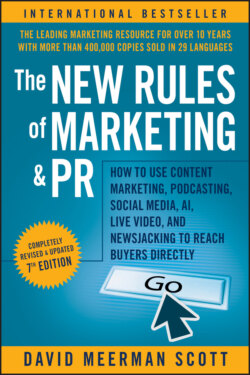Читать книгу The New Rules of Marketing and PR - David Meerman Scott, Kevin Nalty, Steve Garfield - Страница 13
What’s New
ОглавлениеThis seventh edition of the book builds on the completely revised sixth edition with another extensive rewrite. I have checked every story, fact, and figure. But I’ve also listened. In the past decade, I’ve met thousands of people like you, people who have shared their stories with me. I have drawn from those experiences and included in these pages many new examples of success. For those of you who have read earlier editions, you’ll still find many fresh ideas in these pages.
I’ve made some more significant additions as well. The tools of marketing and public relations are constantly evolving. Consider this: When I wrote the first edition of the book, Twitter didn’t even exist and Facebook was available only to students. Now Twitter is an essential tool of marketing, and as of March 31, 2019, Facebook had 2.38 billion monthly active users around the world. And those are just two examples.
Here’s another example of how the ideas in this book have become mainstream: I first wrote about newsjacking, the art and science of injecting your ideas into a breaking news story to generate tons of media coverage, get sales leads, and grow business, back in 2011. I’m honored and grateful that because of people like you who learned about my pioneering ideas around newsjacking in previous editions of this book, the concept has become incredibly popular.
In fact, Oxford Dictionaries listed “newsjacking” in the Oxford English Dictionary in 2017 and named it to the short list of contenders for word of the year. In their announcement, Oxford Dictionaries said: “In the space of a few short years, newsjacking has gone from an experimental technique to a staple in every social media-savvy marketing department’s arsenal. Brands from across industry sectors fully embraced the strategy this year, increasingly taking advantage of current events to not only push their brand into the public consciousness, but to align themselves with certain ethical or moral positions. Blending ‘news’ and ‘hijacking,’ the word itself dates back to the 1970s with reference to the theft of newspapers in order to sell them to scrap dealers. Its contemporary iteration, however, dates from the early twenty-first century, as first popularized by marketing and sales strategist David Meerman Scott.” You will learn about Newsjacking in Chapter 21, where I have added several new examples in this edition of the book.
Since the last edition of the book was published, the number of people using voice assistants from the likes of Amazon, Google, and Apple has dramatically increased. That means understanding how people use voice to ask questions has become an important aspect of Search Engine Optimization, and I’ve added a section about this.
In early 2019 Google shut down its social networking service Google Plus (G+), so I needed to remove that section from the book. Google Plus launched in mid-2011 to great excitement. Initially available by invitation only—a clever ploy to get early adopters like me to sign on—G+ became the fastest growing social network in history when it opened to everybody in September 2011. However, once people started to use the service, it didn’t seem much different than Facebook. Most didn’t stick around. Less than a decade after launch, the service was abruptly shut down. We can learn several lessons from this saga: (1) “Me too” social networks never succeed, and (2) never tie the majority of your personal brand to a single social network.
I used my scalpel to cut other stories and concepts that I felt were no longer appropriate, including an entire chapter on viral marketing that was in previous editions. With the tremendous rise of social media, newsjacking, and real-time connections between people around the world, the fact that information travels quickly and grows in reach is an aspect of many ideas in various chapters in the book. The idea no longer needs its own chapter.
Finally, this edition includes a brand-new chapter on artificial intelligence (AI) and machine learning. Since the last edition of the book was published, the rise of AI in marketing and public relations has become an important way to automate routine tasks to save time and money as well as to increase the success of marketing initiatives. The chapter explores ways that AI can help marketers, such as analyzing which blog or email newsletter topics have the greatest chance of getting seen and shared, the best ways to write headlines for maximum exposure, the best time and day to post it, which channels are the best to share it on, and what hashtags are appropriate to use. As you consider AI in your organization, think about the routine tasks that drive business value that might be possible to automate. Even if you’re not using AI yet, you need to know what’s possible in this, perhaps fastest changing aspect of marketing.
